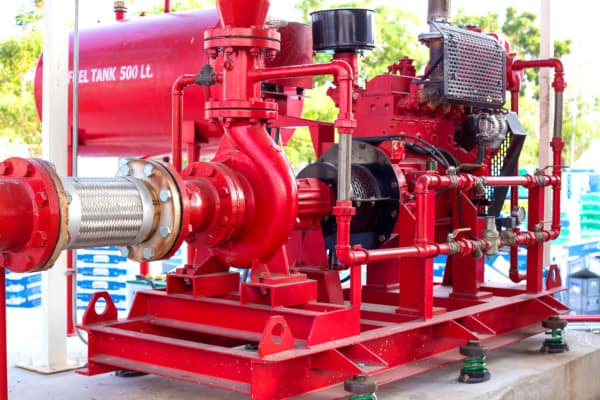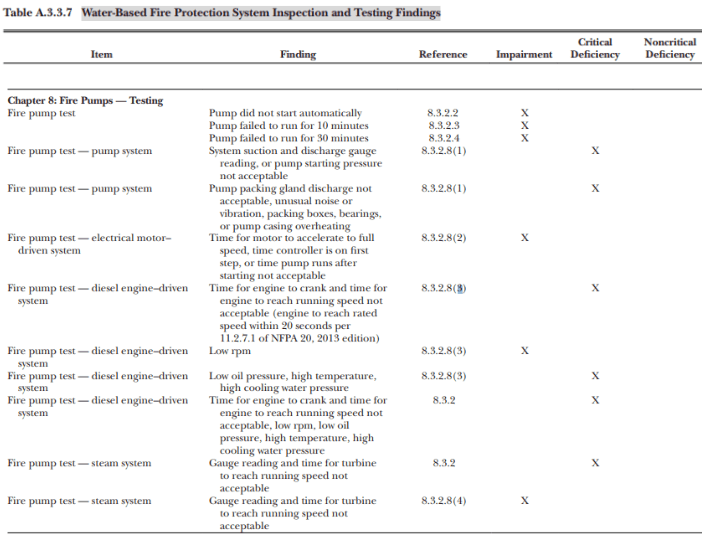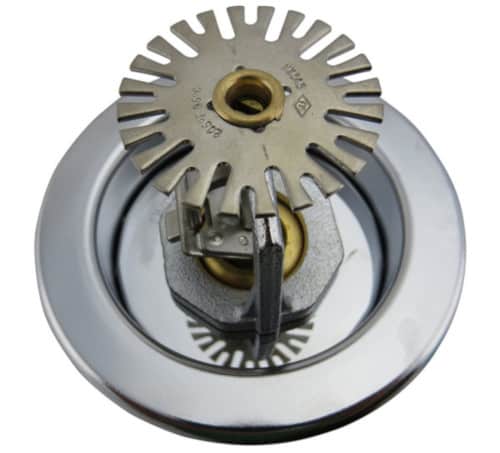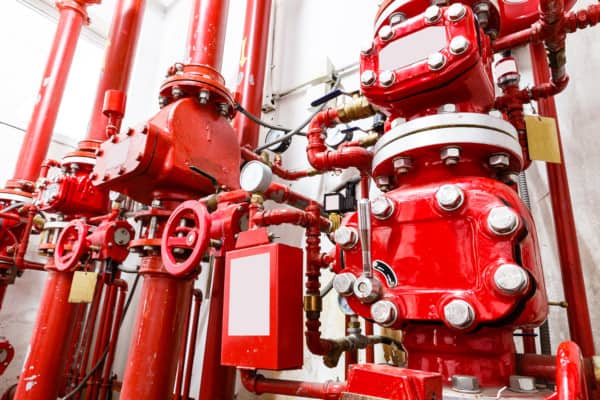NFPA 25 requires more frequent testing of dry sprinklers
Dry sprinkler systems will never be a “set it and forget it” technology. With more complex parts than traditional wet sprinkler systems and regular exposure to freezing temperatures, periodic testing is essential to ensure reliable automatic fire protection. Failing to do so can lead to fines and citations—and potentially catastrophic loss of life and property if the system malfunctions during a fire.
In this installment of our series on dry sprinkler systems, we examine National Fire Protection Association (NFPA) requirements and best practices for testing dry sprinklers on shorter intervals: daily, weekly, and monthly tests.
Stay tuned for future blogs covering requirements for testing that must be performed at least once a year and longer, as well as guidelines for maintaining dry sprinklers.
Are you looking to buy components for your building’s sprinkler system? QRFS offers a range of dry sprinkler heads available on special order. Simply give us a call at 888.361.6662 or email support@qrfs.com.
You can also view our in-stock selection of sprinkler gauges, valves, supervisory switches, and other accessories.
NFPA stipulates tighter testing timelines for dry sprinklers
Dry sprinkler systems offer property owners peace of mind by providing reliable fire protection when temperatures drop below freezing. Unlike wet systems, which risk failure due to water-filled pipes that can burst or freeze in cold weather, dry sprinklers rely on pressurized air or nitrogen to hold back the water supply at a dry pipe valve located in a heated space. The compressed air escapes when heat from a fire activates a sprinkler head, opening the valve and enabling the water supply to enter the pipes and hit the fire.
The 2017 edition of NFPA 25: Standard for the Inspection, Testing, and Maintenance of Water-Based Fire Protection Systems establishes a schedule for testing of dry sprinkler systems. While the standard makes it clear that property owners or their representatives are ultimately responsible for ensuring their sprinkler systems are functioning properly, it does grant the ability to delegate authority (4.1.1) to a representative, and specifies that tests should be done by qualified personnel. System tests are often in-depth and many require expertise to operate the system or one of its parts to make sure it performs to an acceptable standard.
NFPA requires most sprinklers to be replaced or laboratory tested every 10 years after they have been in service for 50 years (5.3.1.1.1), and the frequency changes to every five years after they have been in service for 75. But failure reports in the late 1990s—combined with UL (formerly Underwriter Laboratories) studies and the complex manufacturing elements of dry sprinkler systems—prompted NFPA to significantly shorten that timeline for dry sprinklers to 10 years.
Manufacturing processes have improved since the NFPA timeline was changed, and UL banned the use of O-ring seals in 2003 that were behind many abnormal dry sprinkler operations. But even so, NFPA 25 continues to require laboratory testing or replacement of dry sprinklers on the shorter interval.
From the 2017 edition of NFPA 25
5.3.1.1.1.6* Dry sprinklers that have been in service for 10 years shall be replaced or representative samples shall be tested and then retested at 10-year intervals.
A.5.3.1.1 Sprinklers should be first given a visual inspection in accordance with 5.2.1.1.1 to determine if replacement is required. Sprinklers that have passed the visual inspection should then be laboratory tested for sensitivity and functionality. The waterway should clear when sensitivity/functionality tested at 5 psi (0.4 bar) or the minimum listed operating pressure for dry sprinklers.
5.3.1.2* A representative sample of sprinklers for testing per 5.3.1.1.1 shall consist of a minimum of not less than four sprinklers or 1 percent of the number of sprinklers per individual sprinkler sample, whichever is greater.
5.3.1.3 Where one sprinkler within a representative sample fails to meet the test requirement, all sprinklers within the area represented by that sample shall be replaced.
The greater potential for corrosion in dry sprinklers compared to other systems also contributes to a shorter system lifespan that bears watching. While property owners and facility managers typically expect wet sprinkler systems to last an average of 40 to 50 years before beginning to fail, corrosion can cause dry systems to require replacement within 8 to 12 years.
Before we begin to take a look at specific tests, let’s address some overall requirements:
- NFPA 25 requires property owners or their designated representatives to notify the authority having jurisdiction, the alarm-receiving facility, and the fire department (if required) before testing or shutting down a system or its supply (1.4), as well as when the test is finished and the system is returned to service (4.1.4.2). The notification should include the reason for the test, the system or component involved, and how long it’s expected to take (4.1.4.1).
- Automated testing is permitted as long as it mirrors the manual actions required by the standard for testing a particular device (6.6.3) and produces an audible supervisory signal if a component or system doesn’t pass (4.6.6.8). A trouble signal is also required if the testing equipment itself fails (4.6.6.9). Equipment must be listed for the purpose of the test being conducted and could potentially include transducers, temperature sensors, and automatic and remotely-operated valves, among other choices. (A.4.6.6.2).When testing is required to discharge water, the discharge must be visually observed at least every three years during automatic tests (4.6.6.4.2)—although appropriate remote visual observation can be used. For some tests, NFPA 25 requires people to observe the entire process even if it’s automated, so they can intervene to prevent injury or property damage (4.6.6.5), such as during no-flow tests on fire pumps.
- When documentation of a sprinkler system’s installation date isn’t available, the manufacture date should be used as the start date for the testing timeline (5.3.1).
NFPA 25 recommends timelines for how often various dry sprinkler components should be tested. But read this carefully: It’s important to keep in mind that the tests outlined by NFPA 25 and addressed in this blog are routine, and unusual conditions should prompt additional testing. When that occurs, the type of test conducted and the number and location of samples taken should be appropriate to the problem being investigated. Consultations with the manufacturer, the listing agency, and the authority having jurisdiction can help determine the right course of action.
Daily and weekly tests of dry sprinkler systems
Low point drains
After a dry pipe valve trip, auxiliary low point drains should be drained on a daily basis to ensure that all remaining water and condensate is removed from the system. In a dry sprinkler system which relies on pressurized air (vs. nitrogen) to hold the dry valve closed, pooling water can quickly combine with oxygen to corrode metal pipes, leading to expensive repairs and impacting system performance.
After several days without water draining, the frequency of low point drain testing can be reduced to weekly or as needed (A.13.4.5.3.2). But keep in mind that colder temperatures can cause condensate to form and accumulate in low point piping. Daily draining of low point drains should also be performed before freezing temperatures are expected, and then as needed. If a quick-opening device which speeds the activation of the dry pipe valve is installed, be sure to temporarily remove it from service before draining low points.
13.4.5.3.2* Auxiliary drains in dry pipe sprinkler systems shall be drained after each operation of the system, before the onset of freezing weather conditions, and thereafter as needed.
Watch this video to learn how to empty low point drains:
Weekly and monthly tests of dry sprinkler systems
Fire pump no-flow tests
The fire pump is a critical part of a building’s fire suppression system, providing the water pressure necessary for sprinkler performance when it isn’t sufficiently generated by the water supply. In most cases, NFPA 25 requires a no-flow, or churn, test to be performed weekly for diesel pumps and monthly for electric pumps. The minimum flow for a pump is the churn pressure.
No-flow tests are exactly what they sound like: they don’t require flowing water. Generally, professionals inspect the pump’s pressure and evaluate how long it takes for the motor to achieve that pressure, making any necessary adjustments. The test takes about 30 minutes for diesel motors and 10 minutes for electric motors.
No-flow tests ensure automatic or manual operation of the fire pump upon demand and continuous delivery of the required system output. They also aim to uncover issues that can’t be spotted by inspections.
In 2008, a group of fire pump owners and maintainers collected data to convince NFPA to reduce the frequency of no-flow tests from weekly to monthly, arguing that doing so wouldn’t significantly impact fire pump reliability. After commissioning its own study to test their theory, NFPA found that the failure rate for electric pumps rendered them 99.4 percent reliable when tested weekly and 97.3 percent reliable when tested monthly. For diesel engine pumps, reliability was 99.1 percent when tested weekly and 96 percent with monthly testing. (A.8.3.1.1.2)
Beginning in 2011, NFPA relaxed its standard to allow monthly testing of many electric pumps but hedged its bet by adding an extra layer of protection. It recommends a risk analysis prepared and reviewed by qualified individuals that considers life safety, property values, hazards, and business interruption at the protected property to determine a test frequency that’s appropriate for each situation. For instance, NFPA suggests that fire pumps protecting high-piled storage facilities that are likely to suffer high-impact losses from an uncontrolled fire should undergo more-frequent testing.
8.3* Testing.
8.3.1 Frequency.
8.3.1.1* A no-flow test shall be conducted for diesel engine–driven fire pumps on a test frequency in accordance with 8.3.1.1.1 or 8.3.1.1.2.
8.3.1.1.1 Except as permitted in 8.3.1.1.2, a weekly test frequency shall be required.
8.3.1.1.2* The test frequency shall be permitted to be established by an approved risk analysis.
8.3.1.2* A no-flow test shall be conducted for electric motor–driven fire pumps on a test frequency in accordance with 8.3.1.2.1, 8.3.1.2.2, 8.3.1.2.3, or 8.3.1.2.4.
8.3.1.2.1 Except as permitted in 8.3.1.2.2 and 8.3.1.2.3, a weekly test frequency shall be required for the following electric fire pumps:
(1) Fire pumps that serve fire protection systems in buildings that are beyond the pumping capacity of the fire department
(2) Fire pumps with limited service controllers
(3) Vertical turbine fire pumps
(4) Fire pumps taking suction from ground level tanks or a water source that does not provide sufficient pressure to be of material value without the pump
8.3.1.2.2 A monthly test frequency shall be permitted for electric fire pumps not identified in 8.3.1.2.1.
8.3.1.2.3* A monthly test frequency shall be permitted for electric fire pump systems having a redundant fire pump.
8.3.1.2.4* The test frequency shall be permitted to be established by an approved risk analysis.
8.3.1.3 An annual flow test shall be conducted in accordance with 8.3.3.

How to perform a no-flow test
The 2017 edition of NFPA 25 provides a fairly detailed list of steps and requirements for a no-flow test:
8.3.2* No-Flow Test.
8.3.2.1 A no-flow test of fire pump assemblies shall be conducted in accordance with 8.3.2.
8.3.2.1.1 Except as permitted in 8.3.2.1.2 and 8.3.2.1.3, a main pressure relief valve (where installed) shall be permitted to weep but not discharge a significant quantity of water.
8.3.2.1.1.1 Except as required in 8.3.2.1.1.2, the circulation relief valve shall discharge a small flow of water.
8.3.2.1.1.2 The circulation relief valve shall not operate when the flow through the main pressure relief valve is greater than weeping.
8.3.2.1.2 For fire pump installations that were installed under a standard (1993 and earlier editions of NFPA 20) that did not prohibit a design that required operation of a pressure relief valve to keep the discharge pressure below the rating of the system components, the pressure relief valve shall be permitted to operate as designed during a no-flow test.
Let’s dig into what these requirements mean. A pressure relief valve discharges water when the pressure in a system exceeds certain limits. Fire pump systems should be designed so that a minimum flow verifies that the pressure relief valve is properly set and operating at churn (the normal pressure of the pump when the water is not flowing); larger flows should only be allowed under abnormal conditions, such as engine overspeed.
Circulation relief valves allow water to flow into and out of the system to prevent the water from overheating as the pump adds energy to it. In situations where the discharge from the relief valve is piped back to the pump suction, the fire pump imparts more energy into the water when recirculating it through the pump than when the pump is operating at churn. In those instances, NFPA 20: Standard for the Installation of Stationary Pumps for Fire Protection requires another circulation relief valve to be installed downstream of the pressure relief valve. In fact, NFPA 25 recommends adding circulation relief valves to fire pump systems conforming to editions of NFPA 20 prior to 1999, when they weren’t required. (A.8.3).
The no-flow test can still be performed in systems that lack circulation relief valves, however. Technicians should take suction and discharge pressure gauge readings quickly while there is no flow in the fire protection system, and then create a small flow by opening an inspector’s test connection, alarm bypass, or main drain downstream of the pump to prevent it from overheating during the rest of the test. But be warned: damage is likely to occur if an unattended pump starts without water flowing into the fire protection system because it can quickly overheat.
From the 2017 edition of NFPA 25
8.3.2.1.2.1* The pressure readings on the discharge and suction gauges shall be recorded, and a pressure difference that is greater than 95 percent of the rated pump pressure shall be investigated and corrected.
The importance of calculating the pressure differential between the discharge and suction gauges during a fire pump test can’t be overstated. An excessive pressure differential might indicate that the pressure relief valve is wide open and not properly regulating the pressure. Excessively high flow rates through the pressure relief valve can cause a dry sprinkler system to fail, and also overload and eventually destroy a diesel engine drive.
8.3.2.1.2.2* The discharge temperature of the water shall be monitored and the pump shut down if necessary to prevent exposing the pump and/or driver to excessive temperatures.
8.3.2.1.3 For positive displacement pumps, the pressure relief valve shall operate during a no-flow test.
8.3.2.1.3.1 Where the pressure relief valve is piped back to suction, the pump circulation relief valve shall not operate.
8.3.2.1.3.2 On electric motor and radiator cooled engine drives, a circulation pressure relief valve located downstream of the main pressure relief valve shall discharge sufficient water to prevent overheating of the pump.
Even when circulation relief valves are present, there’s still a caveat: Improperly installed or operating circulation relief valves can result in alarmingly high water temperatures—especially when recirculating the water to the pump suction. These too-hot temperatures can cause diesel engine drives to overheat and fail. Water temperatures must be constantly monitored during testing so the pump can be shut down, if necessary, to avoid damage.
Here are the steps provided by NFPA 25 for conducting a no-flow test:
8.3.2.2 The test shall be conducted by starting the pump automatically.
8.3.2.3 The electric pump shall run a minimum of 10 minutes.
8.3.2.4 The diesel pump shall run a minimum of 30 minutes.
8.3.2.5 A valve installed to open as a safety feature shall be permitted to discharge water.
8.3.2.6 An automatic timer that meets 8.3.2.6.1 through 8.3.2.6.3 shall be permitted to be substituted for the starting procedure.
8.3.2.6.1 A solenoid valve drain on the pressure control line shall be the initiating means for a pressure-actuated controller.
8.3.2.6.2 In a pressure-actuated controller, performance of this program timer shall be recorded as a pressure drop indication on the pressure recorder.
8.3.2.6.3 In a non-pressure-actuated controller, the test shall be permitted to be initiated by means other than a solenoid valve.
8.3.2.7 Qualified personnel shall be in attendance whenever the pump is in operation.
8.3.2.7.1* The use of the automatic timer allowed in 8.3.2.6 shall not eliminate the requirement of 8.3.2.7 to have qualified personnel present during the test.
An automatic timer is not meant to eliminate the need for qualified personnel to remain onsite. Instead, it allows a trained tester to monitor the test and request assistance should any issues arise. NFPA 25 outlines a detailed list of observations, with unique steps for electric, diesel, and steam pumps:
8.3.2.8 The pertinent visual observations or adjustments specified in the following checklists shall be conducted while the pump is idle:
(1) Record the system suction and discharge pressure gauge readings.
(2) For pumps that use electronic pressure sensors to control the fire pump operation, record the current pressure and the highest and the lowest pressure shown on the fire pump controller event log.
(3) If the highest or lowest pressure is outside of the expected range, record all information from the event log that helps identify the abnormality.
8.3.2.9* The pertinent visual observations or adjustments specified in the following checklists shall be conducted while the pump is running:
(1) Pump system procedure is as follows:
(a) Record the pump starting pressure from the pressure switch or pressure transducer.
(b) Record the system suction and discharge pressure gauge readings.
(c) Inspect the pump packing glands for slight discharge.
(d) Adjust gland nuts if necessary.
(e) Inspect for unusual noise or vibration.
(f) Inspect packing boxes, bearings, or pump casing for overheating.
(g) Record pressure switch or pressure transducer reading and compare to the pump discharge gauge.
(h) For pumps that use electronic pressure sensors to control the fire pump operation, record the current pressure and the highest and the lowest pressure shown on the fire pump controller event log.
(i) For electric motor and radiator cooled diesel pumps, check the circulation relief valve for operation to discharge water.
(2) Electrical system procedure is as follows:
(a) Observe the time for motor to accelerate to full speed.
(b) Record the time controller is on first step (for reduced voltage or reduced current starting).
(c) Record the time pump runs after starting (for automatic stop controllers).
(3) Diesel engine system procedure is as follows:
(a) Observe the time for engine to crank.
(b) Observe the time for engine to reach running speed.
(c) Observe the engine oil pressure gauge, speed indicator, water, and oil temperature indicators periodically while engine is running.
(d) Record any abnormalities.
(e) Inspect the heat exchanger for cooling waterflow.
(4) Steam system procedure is as follows:
(a) Record the steam pressure gauge reading.
(b) Observe the time for turbine to reach running speed.
Watch this video for step-by-step instructions on how to perform a monthly churn test:
The table below provides examples for classifying conditions needing repair or correction that are identified by the no-flow test:

The final step: repairs and corrections after dry sprinkler system tests
Documentation of all dry sprinkler system tests must be kept by property owners, but their responsibility doesn’t end there. After the tests are completed, the property owner or designated representative must make sure that corrections and repairs are completed by qualified maintenance personnel or contractors in a timely fashion (4.1.5), ensuring that dry sprinkler systems are ready to offer reliable automatic protection during a fire.
Stay tuned for the next installment in our review of dry sprinkler systems and their applications, in which we’ll explore quarterly and semi-annual testing requirements.

If you’re looking to buy components for your dry pipe sprinkler system, QRFS offers a range of dry sprinkler heads available on special order. Simply give us a call at 888.361.6662 or email support@qrfs.com and we’d be happy to help.
We also stock sprinkler gauges, valves, switches, and other accessories that are applicable in dry systems.
Be sure to check out previous installments in the series:
Guide to Dry Sprinkler Systems, Part 1: System Overview
Guide to Dry Sprinkler Systems, Part 2: Components and Installation Requirements
Guide to Dry Sprinkler Systems, Part 3: Installation of Components
Guide to Dry Sprinkler Systems, Part 4: Installation of Air Compressors and Air Maintenance Devices
Guide to Dry Sprinkler Systems, Part 5: Daily, Weekly, and Monthly Inspection Requirements
Guide to Dry Sprinkler Systems, Part 6: Quarterly, Annual, and Longer Inspections
Guide to Dry Sprinkler Systems, Part 7: Nitrogen Dry Sprinkler Systems Fight Corrosion


